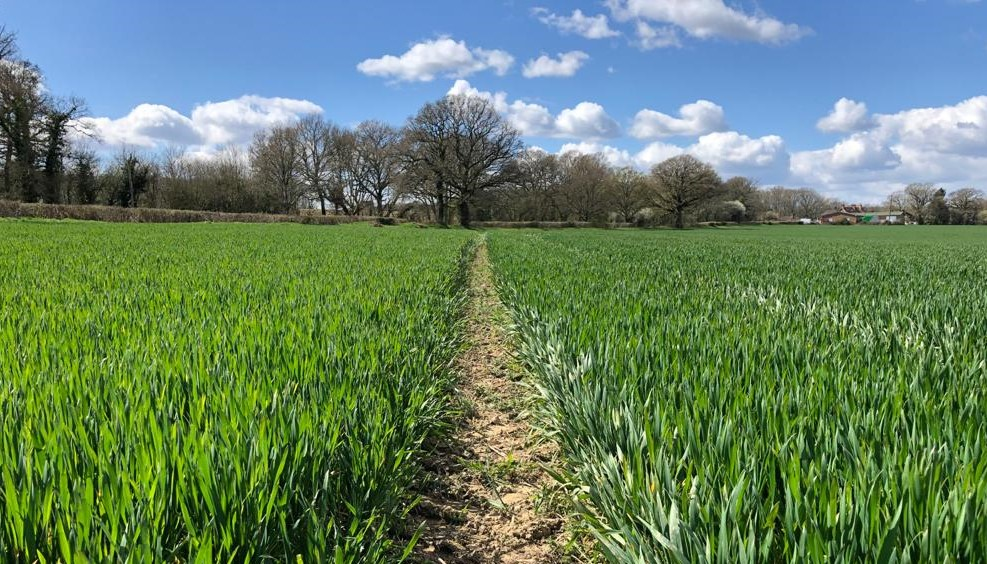The importance of T0 applications this season
February may have been dryer and milder than average, but excessive rainfall in March has not only caused a backlog of fieldwork but also increased disease pressure.
The subsequent delay to the application of T0s presents questions about how they should be approached given the conditions. Today, there are increasing reports of Septoria showing itself on the lower leaves in the crop canopy and this will have inevitably splashed up the crop in the rain over the recent weeks, with the risk even greater in denser, high-biomass crops. Early nitrogen applications in February will also stimulate early growth which, if not addressed at T0 with a plant growth regulator (PGR) application, could lead to increased lodging risk.
T0 is a pivotal start to wheat fungicide programmes, especially in those varieties with both poor yellow rust and poor Septoria ratings such as Skyfall, KWS Zyatt or Gleam. Any variety with a rust or Septoria resistance rating of 6.5 or lower should be considered susceptible.
When assessing a variety's resistance rating and relative risk, remember that sowing date and autumn weather can have an impact on the score. With Septoria scores for example, the mild autumn weather we had at the end of 2022 is equivalent to a drop of around 0.5 to a resistance rating, while a later sowing date towards the end of October will increase it by 0.6. On the contrary, an earlier sowing date such as early to mid-September will decrease it by 0.6.
T0 offers an opportunity to start the season's Septoria control. There is limited 'conventional chemistry' available for use at the T0 timing, but products containing Laminarin have been proven in trials to deliver uplifts in Septoria control throughout the season if applied at T0. Although Laminarin does not have eradicant activity on Septoria, it works by activating a plant's three main defences:
- Reinforcement of the cell walls
- Production of phytoalexins - Create a toxic environment for the pathogen
- Production of pathogenesis-related (PR)proteins - a structurally diverse group of plant proteins that are toxic to invading fungal pathogens.
In terms of yellow rust, T0 offers an opportunity to eradicate any active disease, reducing the inoculum present for when leaf 3 (and other yield contributing leaves) emerge. If yellow rust isn't suppressed with T0 in susceptible varieties, the likelihood of having to actively control the disease for the remainder of the season increases and is there is a risk it could have a greater influence on yield loss than if not treated.
As mentioned earlier, we're seeing some crops with large biomass following a combination of early drilling in autumn 2022 and early nitrogen applications in February. In these instances, the risk of lodging can be higher but T0 PGRs deliver three main benefits where this is the case:
- Enhance rooting – better access to water and nutrients
- Stronger crown roots - reduce risk of stem-based lodging
- Enhance tiller survival.
Without a T0 PGR in high lodging risk crops, firefighting crop height may be required later in the season. This can be costly and is often much less effective at reducing crop lodging, as well as potentially lead to phytotoxic effects on the crop. With this in mind, all crops should receive a T0 PGR application.
T0 is also a key timing to provide the crop with manganese, zinc and copper, especially on lighter soils and soils with a pH >6.5.
If an application is required to maintain plant health, it's best to ensure the correct foliar nutrients are used. These can be applied with other inputs but be sure to check product labels for compatibility. Products which contain the biostimulant R100, such as Program, Cearum and Nutrino Pro, are proven to increase the uptake of Mn, Zn and Cu. For crops suffering moderate to severe manganese deficiency, apply between 250-400g Mn/ha.
Whether it's getting a solid start to disease control, efficient regulation of plant growth or ensuring the crop has all the required micronutrition, there are many reasons to ensure T0s go on as soon as possible.
If T0 has been missed and the crop reaches the T1 timing without any fungicide application, merely increasing doses of T0 fungicides will not suffice as a T1.
In this situation, there is likely to be increased disease pressure, increased lodging risk due to a lack of T0 PGR and micronutrient deficiencies that need to be addressed. As a result, rates of fungicides and PGR need to be carefully addressed and increased/changed to alternative options in order to respond appropriately to the increased agronomic risks.
For more information or advice about T0 and T1 applications, please speak to your local Frontier contact. Alternatively, you can get in touch.
As a subscriber, you’ll receive email alerts each time a new blog is published so you can always stay updated with the latest advice and insights from our experts




Comments